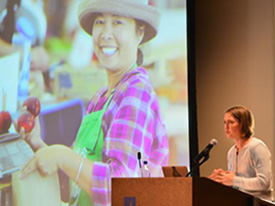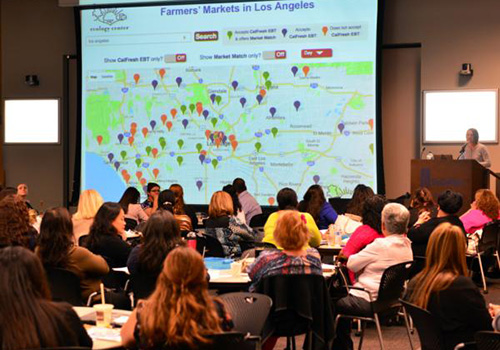 When she’s not visiting farmers’ markets or presenting to county social service agencies around the state, Leah Ricci, Farmers’ Market Access & Equity Program Manager is often leading calls, webinars, or hiring to expand our work to make farmers’ markets more affordable. We caught up with this busy woman to hear how our Market Match program is growing in exciting ways.
When she’s not visiting farmers’ markets or presenting to county social service agencies around the state, Leah Ricci, Farmers’ Market Access & Equity Program Manager is often leading calls, webinars, or hiring to expand our work to make farmers’ markets more affordable. We caught up with this busy woman to hear how our Market Match program is growing in exciting ways.
Ecology Center: What is Market Match? How does it work?
Leah Ricci: Market Match makes healthy food more affordable for low-income Californians and supports local, independent, small-scale farmers by driving federal benefit dollars to farmers’ markets. It works by doubling the value of CalFresh EBT (formerly known as food stamps), and sometimes WIC or SSI, to help shoppers purchase twice as many fruits and vegetables at participating farmers’ markets. A customer spends their CalFresh EBT benefits at a farmers’ market by swiping their card to get tokens or paper scrip to spend in the market like cash. With Market Match, for every dollar of CalFresh that a customer spends, they are given an additional dollar of Market Match scrip that can be used to purchase fruits and vegetables, up to a maximum, per card, per day. At most participating farmers’ markets, this means that a customer can get $20 worth of fresh food, and spend only $10 of their CalFresh benefits.
EC: How does Market Match benefit CalFresh shoppers? How does it benefit the whole community?
LR: Market Match directly benefits CalFresh shoppers by helping them to stretch their food budgets and purchase more fresh, healthy food. It encourages customers to eat more fruits and vegetables, and visit the farmers’ market more frequently. It also helps ensure that farmers’ markets are open and welcoming to all customers, regardless of income-level. Market Match benefits the community as a whole by increasing economic activity – the additional customers who visit a farmers’ market because of Market Match also shop at neighboring businesses. The program provides additional income for small-scale farmers, which in turn supports job creation and economic activity in hard-hit rural areas still recovering from the recession, drought, and now floods. In 2016, the program led to nearly $4 million in farmers’ market purchases by low-income Californians, dollars spent on healthy food, that stay in local economies.
EC: This program has grown by leaps and bounds in the past few years. Who partners with you to make that growth possible?
LR: We have been able to grow the program in recent years in large part due to the support of funders like NIFA (the National Institute of Food and Agriculture) at the USDA, First5 Los Angeles, and Kaiser Permanente. Many county social services and public health agencies throughout the state play a significant role in helping to get the word out about Market Match. And of course, the success of program wouldn’t be possible without the hard work of the 49 farmers’ markets operators and community organizations who are on the ground offering Market Match incentives at over 265 farmers’ markets, mobile farmers’ market stops, CSA pickup sites, and farm stands statewide.
EC: There are 4.4 million Californians using CalFresh. How do you partner with social service agencies to reach all those potential Market Match shoppers? How do they view the program?
LR: Partnering directly with county social service agencies is one of the most effective ways that we can reach customers who can benefit from Market Match. These are the offices where people enroll to get necessary CalFresh benefits, and Market Match primarily serves CalFresh clients, so this is a great partnership. For example, with both Alameda and Los Angeles County Department of Social Services, we have been able to send flyers to tens of thousands of CalFresh households per year, letting them know that CalFresh and Market Match are available at their local farmers’ markets. In addition to reaching CalFresh households through direct mail, social service agencies typically have a team of outreach and enrollment workers who can help spread the word about Market Match. In April, I presented on Market Match at a CalFresh Awareness Month Kickoff training for outreach workers from LA DPSS. It was a great opportunity to answer questions, dispel myths, and provide outreach workers with more resources on how to talk with clients about the program.

In general, social service agencies see Market Match as a huge asset to their community. Particularly for households that receive smaller monthly benefits, which may be as low as $16 per month, Market Match goes a long way in helping low-income households purchase more fresh, healthy food.
EC: What’s next for the program that you are excited about?
LR: In 2016, $5M in state funding was set aside for healthy food incentives in California, through AB1321, creating the California Nutrition Incentive Program, at the California Department of Food and Agriculture (CDFA). In late 2016, we joined CDFA’s application for the next round of USDA grant funding, from the pool that was allocated from the last farm bill. CDFA’s proposal requested $3.9 million in federal funds to support CNIP, including the expansion of the Market Match program, over the next two and a half years. We are still awaiting an award announcement from USDA, but anticipate that this funding will become available in July 2017. Because of the tremendous support on both the state and federal level, we plan to grow and expand Market Match across the state, to more and new locations. This spring, we identified 11 additional Market Match partners, representing 25 farmers’ markets, including several in underserved areas of the state, like Riverside County, Crescent City, Siskiyou County, and Chico.



